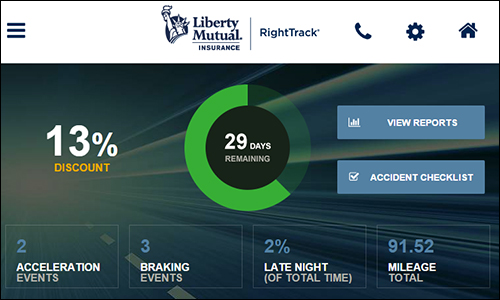In the future, autonomous cars will erase human drivers—and human errors—from the transportation equation. But as long as humans pilot vehicles, insurance companies will want to better gauge their driving behaviors. Throughout the past decade, insurance firms have begun using telemetry systems, in the form of cellular network devices that plug into the onboard diagnostics (OBD) ports, to collect driving behavior data (relating to acceleration and braking, for instance).
According to a recent story published by the Wall Street Journal, insurers have garnered valuable statistics from the massive amount of data they’ve collected through these systems thus far—such as the correlation between hard braking and accidents. Allstate, for example, found that “drivers who slam on brakes more than eight times every 500 miles are 73 percent more likely to get into an accident in a given year,” according to the article.
To entice drivers to participate in these programs, insurers offer rates based on the number of miles driven, or provide discounts for drivers that exhibit safe driving habits. It’s generally called usage-based insurance.
With smartphones becoming ubiquitous and connected cars (with integrated Internet connectivity) becoming more common, insurers are starting to move away from relying on OBD devices to collect driving data. As the above-noted WSJ piece mentions, consumers’ resistance to sharing location data with insurers (early OBD systems collected GPS data) has begun to wane.
Earlier this month, Liberty Mutual announced a partnership with carmaker Subaru, through which Liberty Mutual customers who drive a Subaru with the Internet-connected Starlink infotainment system can participate in the Liberty Mutual RightTrack usage-based insurance program (offered in 39 U.S. states, as well as in Washington, D.C.). These drivers will not need to use an OBD device. Instead, Liberty Mutual will collect driving behavior data through the RightTrack app running on Starlink. Drivers will also receive alerts via the app that inform them when they are consistently breaking too hard, along with other driving tips.
California-based Clarion, which sells audio, multimedia and connectivity services to carmakers, provides the cloud connectivity platform, known as Smart Access, that Starlink uses.
“This is a first-of-its-kind application, and we are very excited about this partnership,” says Jeff Wright, Liberty Mutual Insurance’s VP of usage-based insurance. The firm is also rolling out a version of the RightTrack app that leverages the sensors inside a smartphone to track a driver’s behavior, thereby leapfrogging the need for either an OBD device or a car with an Internet-connected telematics system such as RightTrack. This option, called RightTrack mobile, is currently available in Indiana and Michigan, and is expected to be introduced in Kansas this month.
Relying on OBD devices (also known as OBD dongles) to collect data about driving behaviors has enabled some firms, such as Progressive, to better understand individual drivers’ risks and to price their policies more accurately. However, those business benefits need to be weighed against the costs of distributing and managing those devices, according to James Lynch, chief actuary and director of information services at the Insurance Information Institute. “Over the years, insurers came up with a set of variables, based on the driver’s age, gender and other factors, which did a good job serving as a proxy for directly monitoring driving behaviors,” he explains. “So in order to do a successful usage-based insurance program, the [insurance company’s] costs of managing the dongle would have to a more efficient pricing of product.”
Using a driver’s smartphone or a car’s Internet-connected telematics system to transmit data related to driving behaviors, however, erases the costs associated with OBD devices, and is thus an attractive option to insurers, Lynch says. Plus, while insurers collect data from an OBD device only for a set period of time—say, three months—in order to collect a sample of driving behavior before a customer returns the device, they’ll have no such limitation with a usage-based insurance program that receives information directly from a car or a driver’s phone.
While that means insurers will need to manage far more data, it would also enable long-term data analysis that may reveal trends. “The quality of a driver does change over time,” Lynch says. “For instance, we know that male drivers between the ages of 16 and 25 are not as good as males aged, say 35 to 45. So we know that behavior changes, but where is that breaking point? We may be better at knowing that [through long-term data analysis].”
Liberty Mutual is not the only or first insurance company to leverage connected-car technology or smartphone apps for usage-based insurance. In September 2015, Progressive announced that it had hired Boston-based startup Censio to develop a smartphone-based version of its Snapshot usage-based insurance program, via an app that Progressive plans to roll out to policyholders this year.
Also in September, New Jersey-based Verisk Insurance Solutions, which provides insurers with risk-assessment services and analytics, introduced a new service called Verisk Telematics Data Exchange. Through the service, Verisk will act as the middleman between carmakers that sell onboard connectivity and insurance providers that want to offer usage-based insurance by collecting driving behavior data direct from car telematics services. General Motors, which owns the OnStar telemetry service, is the first carmaker to join the exchange.


